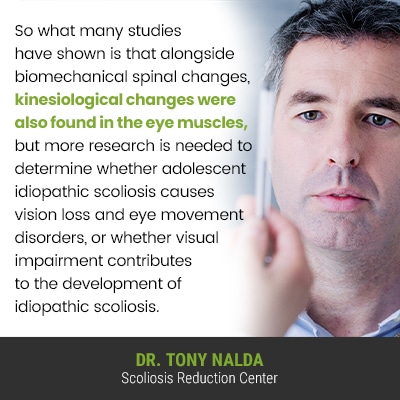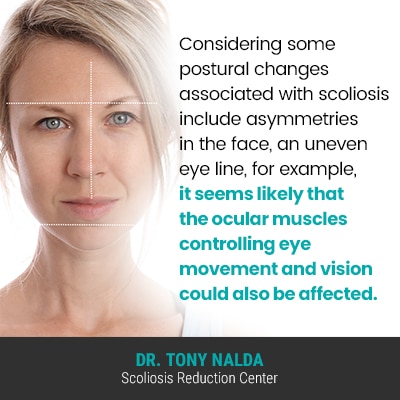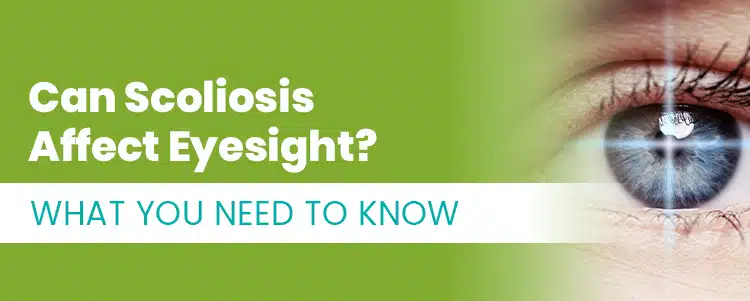Scoliosis introduces a lot of uneven forces to the spine, its surroundings, and the entire body, and as a progressive condition, its effects are likely to get worse over time. The more severe a condition, and/or the longer it’s left untreated, the more likely it is to cause complications like vision problems.
Although scoliosis is a spinal condition, its effects can be widespread throughout the body; adolescent idiopathic scoliosis is linked with clinical vision problems such as myopia, astigmatism, and blindness, but whether that link is more direct or indirect remains unclear.
To better understand the effect of scoliosis on ocular health, we need to understand how the condition disrupts the body’s overall symmetry.
Scoliosis is an Asymmetrical Condition

In general, bodies are symmetrical: two hands, two feet, two eyes, nose centered in the face, even shoulders and hips, and there are a number of conditions that can disrupt the body’s symmetry through postural deviation.
People who develop scoliosis have an unnatural sideways-bending and rotating spinal curve, and progressive scoliosis is virtually guaranteed to get worse over time, and this means the condition’s uneven forces, and their effects, are increasing.
As an abnormal curvature of the spine develops and progresses, the body’s center of gravity is shifting, and this is causing the body to become asymmetrical.
In children for whom scoliosis is not yet compressive, postural changes are the most common scoliosis symptoms:
- Uneven shoulders
- Uneven shoulder blades
- An uneven eye line
- The development of a rib cage arch
- Uneven hips
- Arms and legs that appear to hang at different lengths
Additional changes caused by the condition’s uneven forces and postural deviation include how a person walks, balances, coordinates movements, and disruptions to a person’s sense of proprioception.
As mentioned, scoliosis causes more effects when severe, so before getting to the specifics of scoliosis and vision problems, lets first address condition severity.
Condition Severity
The more severe a condition is, the more likely it is to cause noticeable effects, and remember, as a progressive condition, where a scoliosis is at the time of diagnosis isn’t indicative of where it will stay.
When scoliosis is diagnosed, it’s further classified based on a number of important patient/condition variables: patient age, curvature location, condition type, and severity.
Condition severity is a key piece of information that treatment plans are customized around, and severity is determined by a measurement known as Cobb angle.
A patient’s Cobb angle measurement is determined during X-ray by drawing lines from the tops and bottoms of the curve’s most-tilted vertebrae, and the resulting angle is expressed in degrees:
- Mild scoliosis: Cobb angle measurement of between 10 and 25 degrees
- Moderate scoliosis: Cobb angle measurement of between 25 and 40 degrees
- Severe scoliosis: Cobb angle measurement of 40+ degrees
- Very-severe scoliosis: Cobb angle measurement of 80+ degrees
So when it comes to minimizing the condition’s effects and preventing progression, being proactive with treatment is key, and there is a lot of data on the connection between eye health and scoliosis.
Is Scoliosis Linked with Vision Problems?

One of the changes scoliosis is associated with is proprioception: the ability to orient one’s body position without visual cues.
A person’s vision provides input that shapes proprioception by body position and awareness.
One of the effects of scoliosis asymmetry is a muscle imbalance; it’s not just the spine that’s in charge of maintaining its natural curves and alignment, it’s also the spine’s surrounding muscles that have the task of supporting and stabilizing the spine.
As the unnaturally-curved spine pulls its surrounding muscles in different directions, they struggle to provide the support needed, and can become unbalanced with muscles on one side of the spine being sore and strained from overuse, and the muscles on the other side becoming weak from underuse.
A muscle imbalance can also develop due to the asymmetrical postural changes scoliosis introduces, and as asymmetry can affect the spine’s surrounding muscles, what about eye muscles?
Considering some postural changes associated with scoliosis include asymmetries in the face, an uneven eye line, for example, it seems likely that the ocular muscles controlling eye movement and vision could also be affected.
Studies have been done on how scoliosis affects the visual field in the most common type of scoliosis: adolescent idiopathic scoliosis, diagnosed in adolescents between the ages of 10 and 18.
Postural balance is affected by integrative stimuli: visual, sensory, and the inner ear’s vestibular system, and researchers identify link between inadequate visual systems and the development of scoliosis, but it’s also difficult to determine if vision problems contribute to the development of idiopathic scoliosis, or vice versa.
Another potential link can be found between scoliosis and vision problems because of how scoliosis can affect the flow of cerebrospinal fluid in and around the brain.
Cerebrospinal fluid cushions the brain and spinal cord, providing protection, eliminating waste, and making important nutrients available.
When the spine is unnaturally curved, it can disrupt the flow of cerebrospinal fluid within, and this affects the levels in and around the brain; if there is a build up of CSF fluid behind the eyes, known as intracranial hypertension, this can also cause headaches and vision problems.
So what many studies have shown is that alongside biomechanical spinal changes, kinesiological changes were also found in the eye muscles, but more research is needed to determine whether adolescent idiopathic scoliosis causes vision loss and eye movement disorders, or whether visual impairment contributes to the development of idiopathic scoliosis.
Idiopathic scoliosis doesn’t have a known cause and is thought to be multifactorial, meaning caused by a combination of variables that can differ from patient to patient, so scoliosis affecting the underlying mechanism informing visual stimuli, cerebrospinal fluid levels, and muscle asymmetry has been suggested as a possible theory accounting for the high number of adolescents with scoliosis and visual problems.
Conclusion
Idiopathic means not clearly associated with a single-known cause, but while we don’t fully understand what causes adolescent idiopathic scoliosis to develop initially, we do understand what triggers its progression: growth and development.
Idiopathic scoliosis is considered typical, while atypical scoliosis is associated with known causes: neuromuscular conditions, spinal degeneration, and genetic defects.
Scoliosis can affect all ages but is most known to affect adolescents, and suspected symptoms include postural changes, abnormal development of spinal curves, abnormal head posture, compensatory body posture, involuntary head tilting, pain (more common in adults), uneven shoulders and hips, disruptions to balance, coordination, proprioception, and eye abnormalities.
While there is a potential relationship between spinal problems and relatively poor vision, this could be both directly and indirectly related to asymmetrical ocular muscles affecting horizontal eye movement and blurred vision problems.
A link between ocular health and scoliosis can also be found in how scoliosis affects cerebrospinal fluid levels in and around the brain, and this can cause a fluid build up behind the eyes, known to cause headaches, vision problems, and issues with excessive fluid replacement.
Actual research supports the prevalence of eyesight issues in adolescent patients, and spinal surgery is a common treatment for scoliosis and is linked with postoperative blindness, and while this is a rare complication, the risk is there so should be considered carefully.
Whether scoliosis is considered a genetic disease, as in cases of congenital scoliosis, or idiopathic, as in adolescent idiopathic scoliosis, the condition is linked with eye diseases, retinal ischemia, cortical blindness, acute glaucoma, ischemic optic neuropathy, ocular torticollis, and a variety of optic nerve issues.
Many pediatric patients undergoing strabismus surgery can have issues with an ocular muscle imbalance, and whether or not it’s visual problems that aggravate scoliosis, or scoliosis that aggravates the ocular system remains unclear.
Here at the Scoliosis Reduction Center®, I address scoliosis-related eye-health issues by treating the underlying mechanism causing the complication: the scoliosis itself.
Through an integrative and conservative treatment approach, I help patients work towards condition improvement, preventing progression, and minimizing the condition’s effects, vision problems included.
While there are never treatment guarantees, the earlier scoliosis is diagnosed and treated, the fewer limits there are to what can be achieved.
The early stages of scoliosis in children can be hard to detect, but if conditions are left untreated, the advanced stages can cause overt symptoms and complications such as vision problems; the best way to minimize the condition’s effects is proactive treatment, which is why the best time to start treatment is always now.
While not all patients with scoliosis will experience changes to their eyesight and eye health, there is a link between the two, but to fully understand the nature of that link, more research on the subject is needed.




